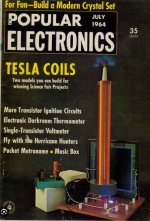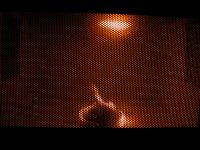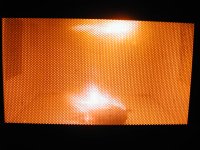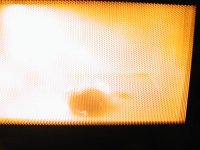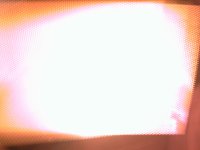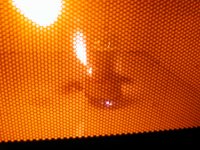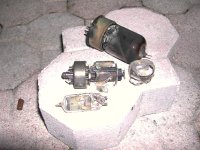Can anyone ID the tube and the possible application of this breadboard setup being sold on eBay? The same seller seems to be selling some crazy PS parts as well.
Breadboard https://www.ebay.com/itm/196323920597
Power supply component? https://www.ebay.com/itm/364772566373
Breadboard https://www.ebay.com/itm/196323920597
Power supply component? https://www.ebay.com/itm/364772566373
The rectifier tubes are 3B28 and the single tube looks like a 304TL or 304TH. The capacitor on the amplifier board says "pyranol" which is bad news. It contains PCB oil which is carcinogenic. As for applications, it doesn't look like it's ham radio related so it could possibly be audio. Personally I wouldn't even dream of plugging that in.
Yeah, it looks like death on a board. The seller also has other bits and bobs, mostly power supply related as far as I can tell. Wonder if this was a high voltage amp project that never got finished.The rectifier tubes are 3B28 and the single tube looks like a 304TL or 304TH. The capacitor on the amplifier board says "pyranol" which is bad news. It contains PCB oil which is carcinogenic. As for applications, it doesn't look like it's ham radio related so it could possibly be audio. Personally I wouldn't even dream of plugging that in.
The owners project is being offered by his heirs & successors.Wonder if this was a high voltage amp project that never got finished.
Some of these, including the one linked in the first post looks like the stuff I built as a kid. I screwed octal tube sockets, terminal strips, and transformers from discarded TV's and radios to a pine board and wired it all up with wire removed from a piece of "50 pair" underground phone cable. Brass furniture tacks were often used as single tie points. I had a guitar amp that I regularly used built like that. Part of the chassis from some unknown electronics found in the trash dump contributed a bracket that held a couple pots and a 1/4 inch input jack.
For some reason, most of these creations are "CUSTOM HEAVY DUTY Tube Amplifiers" even though some have no means of amplifying anything.
For some reason, most of these creations are "CUSTOM HEAVY DUTY Tube Amplifiers" even though some have no means of amplifying anything.
Heh, I bet you didn’t get too many Emiac tubes dumpster diving. And yes, it’s pretty clear the person listing the auctions don’t have any idea what they have. Serious question, does that breadboard lashup look like it is anywhere close to being an actual circuit? There’s a lot of iron and huge capacitors but I can’t make out what is going on. In any case, it doesn’t look like anything I’d want to put 1000v into!Some of these, including the one linked in the first post looks like the stuff I built as a kid. I screwed octal tube sockets, terminal strips, and transformers from discarded TV's and radios to a pine board and wired it all up with wire removed from a piece of "50 pair" underground phone cable. Brass furniture tacks were often used as single tie points. I had a guitar amp that I regularly used built like that. Part of the chassis from some unknown electronics found in the trash dump contributed a bracket that held a couple pots and a 1/4 inch input jack.
For some reason, most of these creations are "CUSTOM HEAVY DUTY Tube Amplifiers" even though some have no means of amplifying anything.
Sorry but all I see there is a pile of junk.Can anyone ID the tube and the possible application of this breadboard setup being sold on eBay? The same seller seems to be selling some crazy PS parts as well.
Breadboard https://www.ebay.com/itm/196323920597
Power supply component? https://www.ebay.com/itm/364772566373
Worth nothing.
Impossible to ship.
Sellers have NO CLUE of what it is, the only person who did is presumably dead.
Mo schematic, not even a label.
Best sellers could do is to separate parts and sell them individually, as in:
- XYZ tube (in unknown state) with its socket
- X volts transformer
- Pyranol filled X uF Y Volts capacitor 🙄
- 5W 100 ohm resistor ......
Somebody might find one of those identifiable useful.
As-is, it's not more than dumpster fill.
Ohh!, that's just an old Time Coherer Vectorizer. No one would want to take a chance now with such an unreliable piece of equipment. The owner probably went back to the 50s to gather up some plentiful new tubes and stayed there. Took the stock market listings along, invested wisely, and stashed 1000s of NOS tubes somewhere in Montana, where he was born later.
Last edited:
I my early youth adventures my "parts stores" were the trash bins behind the two TV repair shops within walking distance of my house, a small landfill trash dump within bicycle distance, and the big land fill that a friend's father took me to several times. It was full of all sorts of stuff including industrial trash.Heh, I bet you didn’t get too many Emiac tubes dumpster diving. And yes, it’s pretty clear the person listing the auctions don’t have any idea what they have. Serious question, does that breadboard lashup look like it is anywhere close to being an actual circuit? There’s a lot of iron and huge capacitors but I can’t make out what is going on. In any case, it doesn’t look like anything I’d want to put 1000v into!
I did get a few 4CX250's, about 20 833A's, and a couple 4-400's, lots of 211's and 845's and a few other oddball transmitting tubes in the warehouse cleanout thing 20+ years ago. I still have a few of the 833A's. I made a 1KW HF linear amp with the 4-400, The others were traded or given away.
Deadly Science Fair Project. Tesla Coil driver with missing HV inductor tower. All the capacitors and inductors for resonating the HV xfmr. The bigger the tube, the more impressive to the judges. ( OK, I consulted AI for the previous guess. Too many SF movie plots digested lately )
Last edited:
Deadly Science Fair Project.
So the Big Dumm Blonde One and a couple friends decide to make something for the school science fair in 1968 or 69. Were we smart enough to think up something on our own? Yes, probably, but when someone gives my friend a large by heavy by ugly metal "thing" with the word "Budweiser" painted on it in bright red, I knew what to do. The "Bud Box" as it was called had powered a large but broken beer sign. We had a better idea taken right from the front cover of a Popular Electronics magazine that I had. Of course, we had to supersize it. The center coil was a 4 foot piece of PVC pipe. The capacitor had several layers of glass and foil.
Things went wrong in several ways but the biggest disaster was a result of some "expert" telling us we had to enclose the scary capacitor and really scary spark gap in plastic boxes. We were in Miami Florida where the humidity is in the super sweat zone for all but a few days in January. Schools were not airconditioned in 1969, however to reduce the risk of kids being electrocuted, the electronics class and lab was airconditioned. Thats where we build BIG TC. It worked, wiped out all TV and AM radio reception for about a mile around the school and lit up two sets of overhead fluorescent lighting when they were turned off. The aluminum foil and glass capacitor let out this evil sounding 120 Hz buzz while the spart gap sounded more like a shrunken jack hammer. Wicked looking lightning bolts shot skyward from the top reaching toward the suspended metal lighting fixtures.
Mr. Expert adviser had the shop class make the required plastic enclosures which were installed, and the BIG TC was moved to the auditorium for a dry run. Upon power up something was obviously off. Everything seemed to be working but there were no wicked lightning bolts, just wimpy sparks and lots of ozone. It did not take long for whatever was accumulating inside the box covering the spark gap to ionize, which led to the plastic melting, dripping into the spark, and catching fire.
The 4 participants were forever banned from entering the school science fair and the teacher was reprimanded for allowing such unsafe fun. The remains of "the coil" were still in the back of the electronics lab for at least two years after I graduated in 1970. Several years later I helped a friend with a smaller vacuum tube Tesla Coil modulated with audio. Those experiments revealed the reason for the lack of lightning bolts in the school auditorium. We all thought the coil had been damaged or knocked out of "tune" hence the tinkering with the spark gap. The later experiments revealed that it was the high humidity that killed the lightning and created the ozone, as my friend's coil worked inside the air conditioned house, but not in the garage.
Fast forward 30 years and my daughter does a simple science fair project called "foods that go boom." How much trouble could you get into with an old microwave oven, a trip to the grocery store and a camera? All experiments were photographed and the results tabulated. The whole project took a few hours in the backyard. Two experiments did discover some potentially dangerous results. One egg will blow the door open when it explodes, a whole carton will blow the door off and crack the glass. Everything was photographed, tabulated, and put on one of those white tri-fold display boards along with a discussion of how a microwave oven actually works. It seems that even some electrical engineers at Motorola didn't fully understand this which became evident in a heated burnt cell phone discussion that resulted in me "nuking" a phone at work one day, planting the seed for the "foods thing." No actual material from the experiments were present at the school science fair. The results from the science fair were NOT what I expected. To my surprise, it WON the school fair, placed second in the county fair and was submitted to the state fair in Tampa, where it was rejected on safety grounds. These experiments were performed before I had a digital camera.
The old microwave lived through these experiments though probably leaked a bit of microwave energy after I rigged the broken door and latch. My own microwave plasma experiments 20+ years ago managed to melt a hole in the oven floor at which point it went into the trash. Note that all of my experiments took place outside with considerable safety precautions in place along with a fail safe mechanism that would abruptly end any experiment that started to go wrong. It was never needed.
So the Big Dumm Blonde One and a couple friends decide to make something for the school science fair in 1968 or 69. Were we smart enough to think up something on our own? Yes, probably, but when someone gives my friend a large by heavy by ugly metal "thing" with the word "Budweiser" painted on it in bright red, I knew what to do. The "Bud Box" as it was called had powered a large but broken beer sign. We had a better idea taken right from the front cover of a Popular Electronics magazine that I had. Of course, we had to supersize it. The center coil was a 4 foot piece of PVC pipe. The capacitor had several layers of glass and foil.
Things went wrong in several ways but the biggest disaster was a result of some "expert" telling us we had to enclose the scary capacitor and really scary spark gap in plastic boxes. We were in Miami Florida where the humidity is in the super sweat zone for all but a few days in January. Schools were not airconditioned in 1969, however to reduce the risk of kids being electrocuted, the electronics class and lab was airconditioned. Thats where we build BIG TC. It worked, wiped out all TV and AM radio reception for about a mile around the school and lit up two sets of overhead fluorescent lighting when they were turned off. The aluminum foil and glass capacitor let out this evil sounding 120 Hz buzz while the spart gap sounded more like a shrunken jack hammer. Wicked looking lightning bolts shot skyward from the top reaching toward the suspended metal lighting fixtures.
Mr. Expert adviser had the shop class make the required plastic enclosures which were installed, and the BIG TC was moved to the auditorium for a dry run. Upon power up something was obviously off. Everything seemed to be working but there were no wicked lightning bolts, just wimpy sparks and lots of ozone. It did not take long for whatever was accumulating inside the box covering the spark gap to ionize, which led to the plastic melting, dripping into the spark, and catching fire.
The 4 participants were forever banned from entering the school science fair and the teacher was reprimanded for allowing such unsafe fun. The remains of "the coil" were still in the back of the electronics lab for at least two years after I graduated in 1970. Several years later I helped a friend with a smaller vacuum tube Tesla Coil modulated with audio. Those experiments revealed the reason for the lack of lightning bolts in the school auditorium. We all thought the coil had been damaged or knocked out of "tune" hence the tinkering with the spark gap. The later experiments revealed that it was the high humidity that killed the lightning and created the ozone, as my friend's coil worked inside the air conditioned house, but not in the garage.
Fast forward 30 years and my daughter does a simple science fair project called "foods that go boom." How much trouble could you get into with an old microwave oven, a trip to the grocery store and a camera? All experiments were photographed and the results tabulated. The whole project took a few hours in the backyard. Two experiments did discover some potentially dangerous results. One egg will blow the door open when it explodes, a whole carton will blow the door off and crack the glass. Everything was photographed, tabulated, and put on one of those white tri-fold display boards along with a discussion of how a microwave oven actually works. It seems that even some electrical engineers at Motorola didn't fully understand this which became evident in a heated burnt cell phone discussion that resulted in me "nuking" a phone at work one day, planting the seed for the "foods thing." No actual material from the experiments were present at the school science fair. The results from the science fair were NOT what I expected. To my surprise, it WON the school fair, placed second in the county fair and was submitted to the state fair in Tampa, where it was rejected on safety grounds. These experiments were performed before I had a digital camera.
The old microwave lived through these experiments though probably leaked a bit of microwave energy after I rigged the broken door and latch. My own microwave plasma experiments 20+ years ago managed to melt a hole in the oven floor at which point it went into the trash. Note that all of my experiments took place outside with considerable safety precautions in place along with a fail safe mechanism that would abruptly end any experiment that started to go wrong. It was never needed.
Attachments
There's no connection to the plate pin on top of the large power tube.Can anyone ID the tube and the possible application of this breadboard setup being sold on eBay? The same seller seems to be selling some crazy PS parts as well.
Breadboard https://www.ebay.com/itm/196323920597
Power supply component? https://www.ebay.com/itm/364772566373
There appears to be a finned plate cap lying on the breadboard. Possibly has a wire connected to it.There's no connection to the plate pin on top of the large power tube.
Could plastic foam the whole thing in the cardboard box. Good luck "unpacking" it.Shipping would be a disaster in the making.
Some microwave oven experimenters were claiming to make Ball Lightning years back. Not sure what they burned up to do that. Steel wool Brillo pads?"foods that go boom."
..
Last edited:
There's no connection to the plate pin on top of the large power tube.
No connection to the grid pin on the side either, though a suitable cap is nearby.
Two pins on the base of the tube socket are jumpered together. I am not familiar with this tube type, so I don't know if this is normal.
Note that any of these experiments will destroy the oven and could be dangerous if not well controlled. Excessive energy leakage will occur if any portion of the oven cavity seal is breached. Even though it was still capable of making plenty of power, the experiments ended and the oven was trashed when an arc created by nuking a vacuum tube cracked the glass like oven floor and burned through the metal subfloor. Note the small ball of fire at one of the pins on the bottom of a very dead 6146 tube. Here the glass envelope of the tube itself was actually on fire and continued to burn after the power was killed and the oven door pried open. Part of one side of the plate was consumed as well.
A steel wool pad makes a good fireworks display since large currents are induced in fragments about 1.25 inches long (1/4 wavelength at 2450 MHz). These fragments burn making other fragments suitable from receiving large amounts of energy. The process repeats until all of the material is used up, or there are no fragments capable of picking up sufficient energy to burn (too short).
The plasma ball created in my experiment was created by nuking a Brillo pad (steel wool coated with soap). Here the soap will burn with a very sooty (carbon) flame which will ionize and create a large plasma ball. Sources claim that if the oven door is opened, sometimes the plasma will venture out of the oven and move around. I did not try this since my oven's door latch was broken and it was wedged shut. Smaller versions of this experiment can often be made with an ordinary wooden stick match that was already lit.
Attachments
- Home
- Amplifiers
- Tubes / Valves
- Breadboard madness
